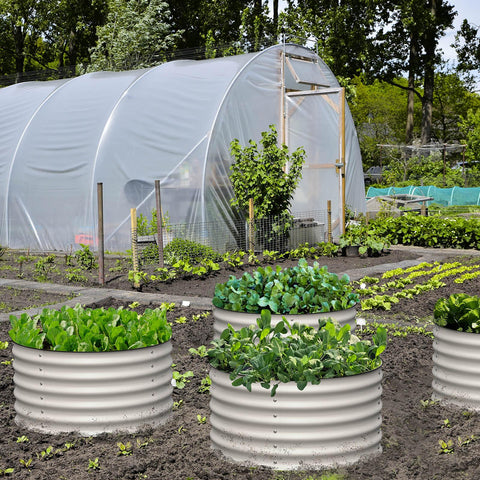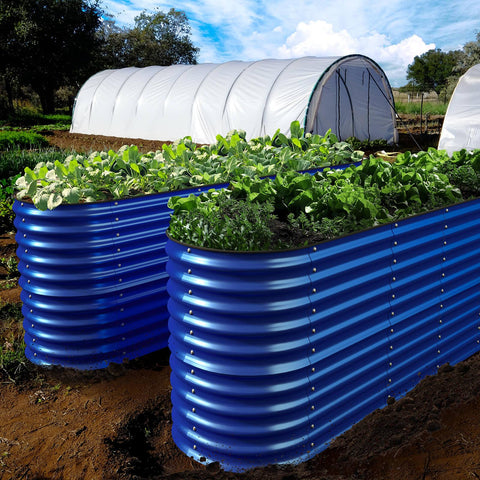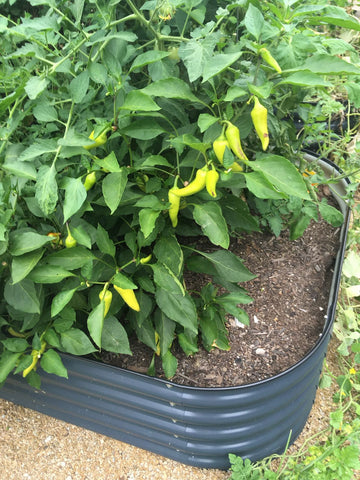Tips from Olle Garden Bed: Six Methods to Protect Plants from Frost
Most gardeners are eager to plant something in their gardens after the long winter. Unfortunately, Jack Frost may not be ready to completely release his cold grip, which may bring us some unexpected frost at the end of spring. The following content also has some reference value for raised garden beds.
The tender garden plants can't stand frost. Therefore, it is better to use these methods to protect plants from accidental frost than to lose them.
Memorial Day weekend is a traditional time to plant gardens for my area. This seems safe because our average last frost day is the middle of May. The weather in spring often teases us with sunny days and warm nights, which is enough to make us believe that winter is finally over. Let the gardening season begin!
Even if you wait to plant the vegetable garden far more than the average last frost date, sometimes Mother Nature will surprise you. Over the years, I have learned to pay close attention to the weather and be prepared to protect frost sensitive plants when the night temperature drops close to freezing.

Which vegetables frost easily
Frost occurs when the ground air temperature drops below 32 ° F (0 ° C). Hard frost or freezing refers to the period when the temperature is below 28 ° F (- 2 ° C) for at least four consecutive hours.
Many plants can survive the short frost, but few can survive the severe cold. When the liquid in plant tissue freezes and breaks due to low temperature, freezing damage will occur.
Some plant tissues are flexible and can withstand a certain amount of internal icing without serious damage.
Plants that may be damaged by light frost:
The garden crops most vulnerable to unexpected late spring frost are seedlings and heat loving summer crops. Any plant specified on the seed package planted after all frost hazards have passed cannot resist accidental frost.
Frost tender plants include beans, corn, cucumber, eggplant, melon, okra, pepper, pumpkin, sweet potato and tomato. If not protected, these plants will be damaged or killed by frost.
Plants that can withstand light frost:
Semi hardy vegetables can survive a slight frost that drops to 32 ° F. These include artichokes, Chinese cabbage, Chinese cabbage, cauliflower, celery, collards, lettuce, mustard, peas, potatoes and radishes.
Plants that can withstand severe frost:
Mature, hardy plants can tolerate lower temperatures as low as 20 ° F. However, new grafts and seedlings may be vulnerable. These vegetables include arugula, broccoli, brussels sprouts, beets, cabbage, carrots, collards, turnips, leeks, onions, parsnips, radishes, turnips, spinach, Swiss beets and radishes.
Six methods to protect plants from accidental frost
Sudden cold current and temperature change will damage frost sensitive vegetables. Here are several ways to protect your plants from unexpected overnight frost:
Watering plants during the day
Thoroughly water the garden soil during the day before predicting late frost. Moist soil can withstand four times more heat than dry soil. When the soil releases water and warms the air near the ground, it also conducts heat.
Watering the garden when the temperature is still above freezing will help maintain some heat when the temperature drops overnight.
Cover plants with old blankets and sheets
Old blankets and sheets are a good way to protect plants from frost. Blankets will help insulate soft plants and keep them alive on cold nights.
Use stakes or hoops to hold the material away from the leaves and drape the blanket over the plant until it touches the ground. Fix the edge with wood, stone or brick to fix it in place to prevent cold air from seeping in
Slide the old pillowcase over the tomato cage to form an insulating air pocket around the plant. You can cover these with extra blankets for extra protection.
Cover in the evening before sunset. Remove the cover in the morning to avoid overheating the plant.

Protect your garden with hoops and plastic
Use the growth tunnel mini greenhouse to protect your plants from frost at night. Or use 10 foot long PVC to make hoop on the elevated bed, and use 5 mils of painted plastic to hang to freeze the fixed edge to keep heat in and cool.
Wait until the sun starts to set, so your plants won't overheat. Remove the plastic in the morning to let your plants breathe naturally and warm.
Place the container on the tender seedling
Place buckets, flower pots, storage bags, trash cans, clock boxes or any large containers on the tender seedlings. If the wind blows gently, press it with stones or bricks.
These containers will form an insulated pocket around your plant. Prevent cold air from seeping in, and keep the waste heat of soil near plants. In the morning, when the temperature rises above freezing point, remove the lid. Use garden frost blanket or row cover
The antifreeze blanket, floating row cover and garden quilt are made of light woven materials specially made for protecting plants. The fabric allows some light penetration and breathability, so if you need extended protection, it can be maintained during the day.
The thickness of frost blanket varies. A thicker quilt protects plants to a greater extent than a thinner row cover. The thinner row cover can protect plants as low as 28 ° F, while the thicker frost cover can protect plants as low as 24 ° F.
Like other coverings, frost blankets work by expelling cold air and forming insulating cavities around plants. The heat from the soil is warmer than the air, trapped under the blanket and close to the plants.
Use hoops or fences to form arches on plants, cover them with frost blankets, and secure the edges to keep heat in and cold air out. When the threat of frost is over, you can remove the frost blanket. Or, because the fabric is breathable, you can keep it for additional protection. Be sure to check your plants to ensure they do not overheat.
Heating
If the predicted overnight frost is unusually cold, additional heat may help prevent plants from freezing. In addition to covering frost tender plants, you can also increase heat under the cover.
Fill milk cans and containers with hot water and place under protective covers as an additional source of heat around plants.
Use a string of older non LED lights to help plants stay warm. String the lights along the arched support below the cover. Prevent the light from touching your plants and fabrics.
Tips for covering garden plants to prevent freezing
When to insure: When frost is predicted, water the plants in the daytime, so that the moist soil can absorb the light energy from the sun. The heat will gradually radiate from the soil to the air overnight. In the late evening before sunset, cover plants to form a tent on the soil to hold a bag of warm air.
Full coverage: The purpose of covering plants is to trap warm air under the canopy. Make sure your cover reaches the ground and is secured in place with wood, stone, or bricks to keep warm air in and prevent cold air from seeping in.
Keep the cover away from the pants: Make sure the cover does not touch the plants. Materials that cover plants, if in contact, can transfer moisture and cold to the leaves. Use stakes or hoops to prevent the cover from touching the plants.
Remove the cover in the morning: Remove the cover in the morning to let the plants warm naturally. Heat from the sun can form under a solid cover, and plants may die from high temperatures.
What should you do if you find frost damaged plants
It is easy to be caught off guard by unexpected frost. Once you wake up in a cold morning, what should you do?
If your young plants are damaged by frost, they may have blackened leaves, withered stems and leaves, or even the whole plant may fall down.
Give plants time to thaw and warm naturally. Sometimes, you will find that only a few leaves on the top of the plant have been killed by frost. In the afternoon, these will look shriveled and withered. Just trim the damaged leaves and your plant will recover.

Plants with black leaves and stems are unlikely to recover. Or, even if they do, they will be weak and will not produce much harvest. Replace these plants with healthy ones.
If an unexpected late spring frost strikes, the loss of young garden plants may be very disappointing. I hope these tips will help you prepare to protect frost sensitive plants when night temperatures approach freezing.
